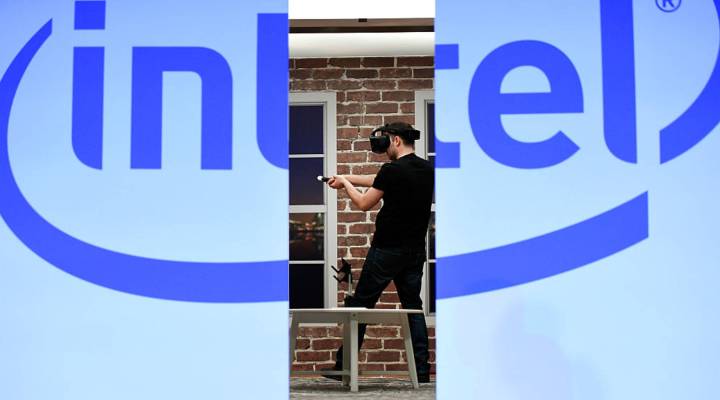
Intel says Moore’s Law lives on

It’s time for a little refresher on something called Moore’s Law: More than half a century ago, Intel co-founder Gordon Moore predicted that, essentially, processor power would increase exponentially over time.
Yes, it’s more complicated than that. But for decades, the general principle has pretty much held true, leading to faster and cheaper computing power that enables supercomputers in our pockets, self-driving cars, smart refrigerators and more.
But there’s a popular belief these days that chip makers just won’t be able to keep up with Moore’s Law anymore.
For more on Moore, Marketplace’s Molly Wood spoke with Stacy Smith, the executive vice president leading manufacturing, operations and sales for Intel. Below is an edited transcript of their conversation.
Molly Wood: So you are in San Francisco, as I understand it, talking about, of all things, Moore’s Law. I have heard rumors that Moore’s Law may have been killed off, but you say not so fast.
Stacy Smith: The rumors of Moore’s Law’s death stretch back 25 years. And what happens is the smart technologists figure out ways to continue to advance it and solve problems that, you know, they had supposed were insurmountable. And the beauty of that force is that it lets us bring down costs and bring more capable products to the marketplace year in, year out.
Wood: And what has, for those who have not followed this story arc, what has Moore’s Law playing out over time meant for Intel’s business in particular as you keep building computer chips?
Smith: Yeah, it’s huge, it is. It’s the economic law that really drives our business. And in fact it’s … huge for the industry and the economy at large. Specifically for us, what it means is that every generation we can bring out new capabilities that enable people to have new usage models like immersive virtual reality or to solve the big problems of the world by putting, you know, supercomputers to work on mapping the genome — those kinds of things. And we can do it at a lower cost and more capability.
Wood: At what point does physics start to get in the way? I know that you’ve already had to cross what seemed like impassable barriers to keep making transistors smaller and more powerful. How long can it go on?
Smith: Yeah, it’s a great question. I was in the factories back in 1990, so 25 years ago, and that was the point at which the line that we were trying to scribe on a wafer for was more narrow than the wavelength of light. And we used something called lithography to do that, so it was actually, think of it as almost a photo process. And that was seen as an insurmountable technology barrier — there’s just no way the industry could progress past the wavelength of light. And it wasn’t even a speed bump. The reality is that the smart men and women that work in these factories and technology development, they find ways to use X-rays, they find ways to bend light by putting it through water. And they continue to solve these problems.
Wood: What does this mean for the actual physical creation of these transistors? Like, are we talking about the tiniest robots building the tiniest chips?
Smith: We have highly automated factories. I wouldn’t say it’s robots building chips. You know, each factory that we build has thousands of people. The work that they do is very different than what they used to do. It’s moved from, you know, physically touching the wafer to being engineers to make sure that the equipment that’s manufacturing the products is doing that with a high level of precision. I think the big impact of Moore’s Law though is just that basic model of being able to double the capability every year or bring the cost down every year, or every two years, excuse me, is the fundamental driver…. I shared some — if I can digress — I shared some fun data that we had pulled up that said if other industries progressed at the same kind of doubling of capabilities every two years that Moore’s Law had, and if you apply the same metric to something like gas mileage, it says you could drive to the sun from the earth on a single gallon of gas. You could drive that distance with a single gallon of gas. It’s just a phenomenal driver of our business and the economy.
Wood: It seems like every day we have some new vision [of the future], whether it’s, you know, virtual reality, completely immersive virtual reality, self-driving cars, missions to Mars. How much of that actually depends on you being successful in extending the life of Moore’s Law?
Smith: Yeah. All of it. You know, if we stopped being able to advance the capabilities of computers, we would stop advancing our capability to solve some of these problems. I mean, it’s as simple as that.
Wood: Stacy Smith from Intel, thank you so much.
There’s a lot happening in the world. Through it all, Marketplace is here for you.
You rely on Marketplace to break down the world’s events and tell you how it affects you in a fact-based, approachable way. We rely on your financial support to keep making that possible.
Your donation today powers the independent journalism that you rely on. For just $5/month, you can help sustain Marketplace so we can keep reporting on the things that matter to you.












